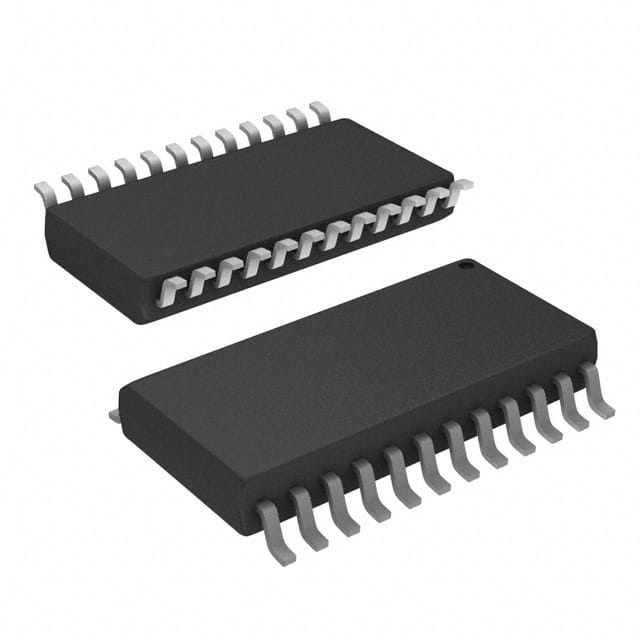AD7710ARZ
Product Overview
Category
AD7710ARZ belongs to the category of analog-to-digital converters (ADCs).
Use
The AD7710ARZ is primarily used for converting analog signals into digital data. It finds applications in various industries, including telecommunications, industrial automation, and scientific research.
Characteristics
- High precision: The AD7710ARZ offers high-resolution conversion, ensuring accurate measurement of analog signals.
- Low power consumption: This ADC is designed to operate efficiently with minimal power consumption.
- Fast conversion speed: The AD7710ARZ provides fast conversion rates, enabling real-time data acquisition.
- Wide input voltage range: It can handle a wide range of input voltages, making it versatile for different applications.
Package
The AD7710ARZ comes in a small outline integrated circuit (SOIC) package, which ensures easy integration into electronic systems.
Essence
The essence of the AD7710ARZ lies in its ability to convert analog signals into digital data with high precision and efficiency.
Packaging/Quantity
The AD7710ARZ is typically packaged in reels or tubes, containing a specific quantity of units per package. Please refer to the manufacturer's specifications for detailed packaging information.
Specifications
- Resolution: 16 bits
- Input Voltage Range: ±10V
- Conversion Rate: Up to 50k samples per second
- Power Supply: +5V
- Operating Temperature Range: -40°C to +85°C
Detailed Pin Configuration
- VDD: Power supply voltage input
- AGND: Analog ground reference
- REFOUT: Reference voltage output
- REFIN: Reference voltage input
- AIN1(+): Positive analog input
- AIN1(-): Negative analog input
- AIN2(+): Positive analog input
- AIN2(-): Negative analog input
- DVDD: Digital power supply voltage input
- DGND: Digital ground reference
- DOUT/RDY: Data output/Ready signal
- SCLK: Serial clock input
- DIN: Serial data input
- CS: Chip select input
Functional Features
- Differential Input: The AD7710ARZ supports differential input, allowing for accurate measurement of signals with common-mode noise rejection.
- On-Chip Calibration: It features an on-chip calibration function that compensates for offset and gain errors, ensuring accurate conversion results.
- Serial Interface: The ADC utilizes a serial interface for easy integration with microcontrollers and other digital devices.
Advantages and Disadvantages
Advantages
- High precision conversion
- Low power consumption
- Fast conversion speed
- Wide input voltage range
- On-chip calibration for accuracy
Disadvantages
- Limited resolution compared to higher-end ADCs
- Requires external reference voltage for optimal performance
Working Principles
The AD7710ARZ operates based on the principle of successive approximation. It samples the analog input voltage, converts it into a digital value using an internal ADC, and outputs the result through the serial interface. The on-chip calibration function compensates for any offset and gain errors, ensuring accurate conversion.
Detailed Application Field Plans
The AD7710ARZ can be applied in various fields, including: 1. Industrial Automation: Used for precise measurement and control in manufacturing processes. 2. Telecommunications: Enables accurate signal processing in communication systems. 3. Scientific Research: Provides high-resolution data acquisition for scientific experiments and analysis.
Detailed and Complete Alternative Models
- AD7790: Similar to AD7710ARZ but with higher resolution (24 bits).
- ADS1115: Offers 16-bit resolution with integrated programmable gain amplifier.
- MCP3424: 18-bit ADC with low power consumption and I2C interface.
These alternative models provide similar functionality to the AD7710ARZ but may have different specifications and features. It is recommended to review their respective datasheets for detailed information.
Word count: 537 words
Lista 10 Vanliga frågor och svar relaterade till tillämpningen av AD7710ARZ i tekniska lösningar
Sure! Here are 10 common questions and answers related to the application of AD7710ARZ in technical solutions:
Q: What is the AD7710ARZ? A: The AD7710ARZ is a high-resolution, sigma-delta analog-to-digital converter (ADC) designed for precision measurement applications.
Q: What is the resolution of the AD7710ARZ? A: The AD7710ARZ has a resolution of 24 bits, allowing for highly accurate measurements.
Q: What is the input voltage range of the AD7710ARZ? A: The AD7710ARZ has a differential input voltage range of ±2.5V, making it suitable for a wide range of applications.
Q: Can the AD7710ARZ be used for temperature sensing? A: Yes, the AD7710ARZ can be used for temperature sensing by connecting a temperature sensor to its inputs.
Q: Does the AD7710ARZ require an external reference voltage? A: Yes, the AD7710ARZ requires an external reference voltage for accurate conversions.
Q: What is the maximum sampling rate of the AD7710ARZ? A: The AD7710ARZ has a maximum sampling rate of 19.2 kHz, allowing for fast and precise measurements.
Q: Can the AD7710ARZ interface with microcontrollers or other digital devices? A: Yes, the AD7710ARZ features a serial interface that allows it to easily interface with microcontrollers or other digital devices.
Q: Is the AD7710ARZ suitable for battery-powered applications? A: Yes, the AD7710ARZ has low power consumption and can be used in battery-powered applications.
Q: Can the AD7710ARZ be used for strain gauge measurements? A: Yes, the AD7710ARZ can be used for strain gauge measurements by connecting the strain gauge to its inputs.
Q: Are there any evaluation boards or development kits available for the AD7710ARZ? A: Yes, Analog Devices provides evaluation boards and development kits that can help with the implementation and testing of the AD7710ARZ in various applications.
Please note that these answers are general and may vary depending on specific application requirements.


